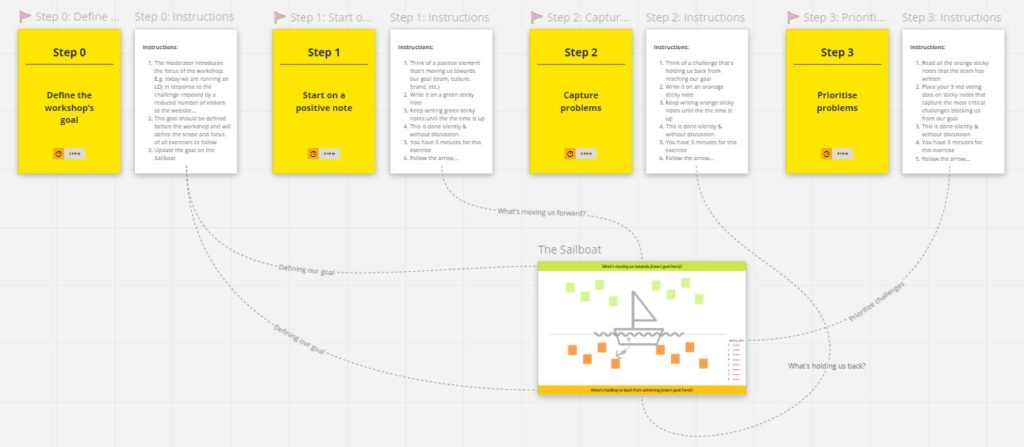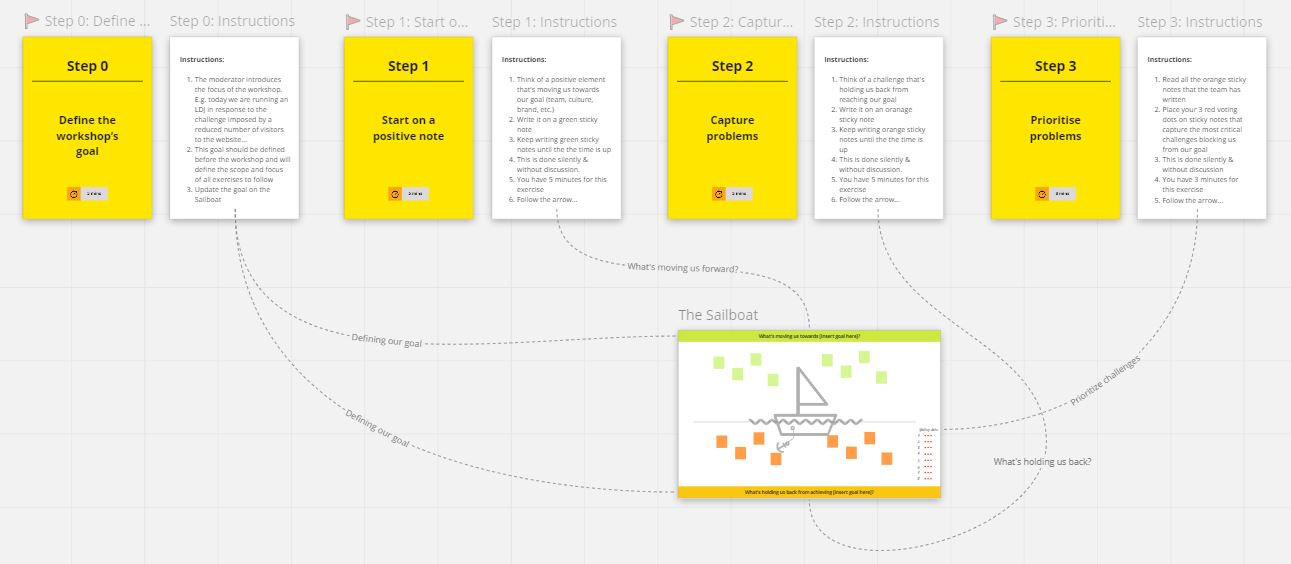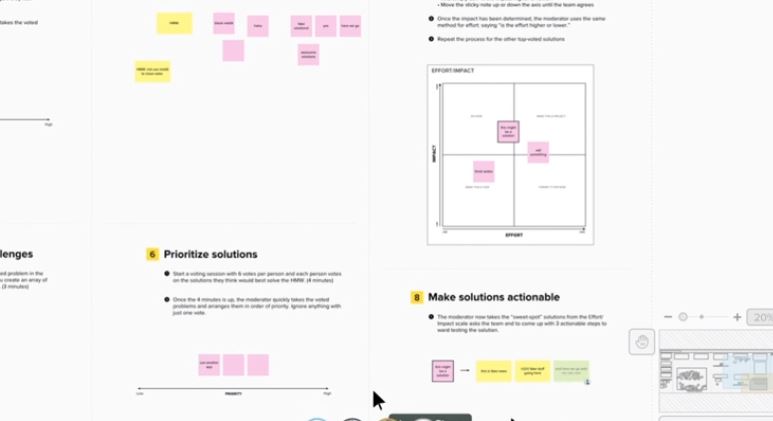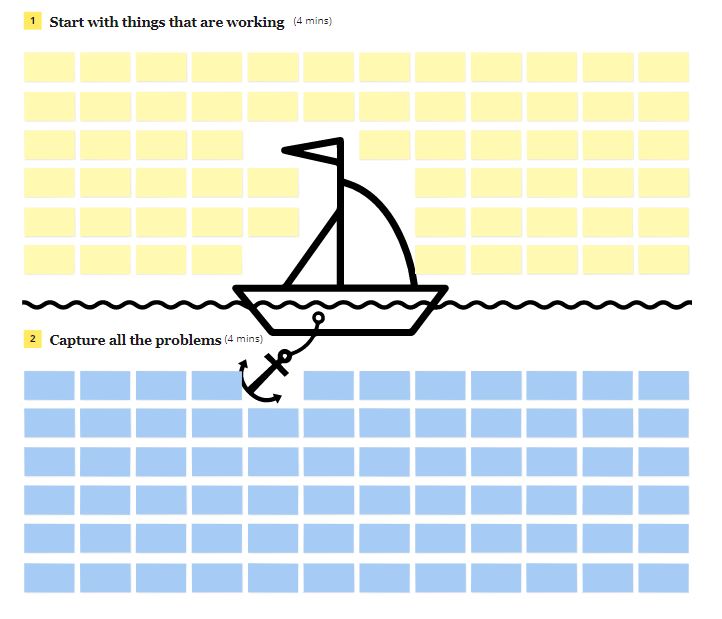Templates to help you conquer this innovative meeting format.
The Lightning Decision Jam (LDJ) is a short design sprint exercise advanced by the team at AJ&Smart (check out the latest Strategy Signal Workshop) that has since gained popularity across the design thinking and innovation space. The series of activities is designed to help teams quickly identify and define a problem, come up with a list of creative solutions, choose the best solution, and develop a series of clear action steps. For teams who want to collaborate, innovate, and build better together, this format can be incredibly effective – and even fun! In today’s guide, we’ll cover the original AJ&Smart lightning decision jam templates available on Miro and Mural, as well as a virtual LDJ template designed specifically for remote teams. An activity like this could also be an engaging part of a design thinking workshop.
💡 What is the Lightning Decision Jam?
The Lightning Decision Jam (LDJ) is a fast-paced workshop method for identifying challenges, brainstorming solutions, and aligning on actionable next steps—all within a single structured session. Originally developed by AJ&Smart, LDJ is designed to combat unproductive meetings by removing debate, encouraging quiet ideation, and using structured decision-making.
Unlike traditional brainstorming, LDJ avoids endless discussion by prioritizing silent thinking, time-boxed steps, and democratic voting. It’s widely used for team retrospectives, innovation sprints, service improvement, and even cross-functional decision-making.
Whether you’re facilitating in-person or remotely, LDJ offers a repeatable, efficient framework for turning complex problems into clear, actionable steps.
✅ Quick LDJ Process Overview
Here’s a simplified breakdown of the core LDJ steps (which most Miro and Mural templates follow):
Set the Stage
Define a clear prompt or challenge area (e.g., “How might we improve our onboarding process?”).Note the Problems
Each participant writes challenges or frustrations silently on digital sticky notes (5–7 min).Vote on the Most Pressing Challenges
Participants use dot-voting to identify the issues that resonate most with the group.Reframe into “How Might We” Questions
The top-voted problems are rewritten into HMW (How Might We) format to spark solution-focused thinking.Ideate Solutions Silently
Participants generate as many ideas as possible in a time-boxed format.Vote on the Best Ideas
Another round of dot-voting helps narrow the focus to the most promising ideas.Prioritize Actions
Using an impact/effort matrix, participants sort ideas and agree on which to pursue first.Define Next Steps
Assign clear owners and deadlines to each selected action to ensure accountability.
This format ensures that everyone contributes, the loudest voice doesn’t dominate, and the group walks away with real decisions and actions—not just ideas.
🎯 Best Practices & Facilitation Tips
To make your Lightning Decision Jam as effective as possible, keep these facilitator tips in mind:
✅ Before the Session
Clarify the purpose. Be specific about the focus challenge or opportunity area.
Prep the board. Use pre-built Miro or Mural templates to save time and keep participants oriented.
Invite the right people. Aim for 4–8 diverse voices who can contribute perspectives and make decisions.
🧩 During the Session
Time-box everything. Use a timer (like Miro’s built-in one) to keep momentum—5–7 minutes per step is ideal.
Enforce silence. Encourage participants to ideate independently—no group discussion during early steps.
Use the “dot vote” wisely. Ask participants to vote on ideas that are impactful and realistic, not just exciting.
🛠️ After the Session
Summarize the outcomes. Share a screenshot or export of the top ideas and chosen actions.
Assign owners. Ensure each next step has a person responsible and a timeline.
Plan a follow-up. Schedule a short check-in in 1–2 weeks to review progress and learnings.
By following these tips, your LDJ session becomes more than a one-time event—it becomes a high-leverage tool for continuous innovation and alignment.
Lightning Decision Jam Templates
1. AJ&Smart’s LDJ Miro Template
The original lightning decision jam template walks you through the entire process, step-by-step. This format is great for internal design processes, organizing events, keeping up with the competition, and improving sales flow processes.
2. Mural Lightning Decision Jam Template
Don’t use Miro? No problem! You can still gain access to a template created by the AJ&Smart team on the other top whiteboarding software tool, Mural. This template also contains a step-by-step guide to following the LDJ process. Make faster decisions and generate better, more creative ideas through this innovative process.
3. Remote Jam Template
For remote teams, you may want to use this slightly adapted template from Miro. The fill-in-the-blank approach allows for easy adaptation by team members who are new to the process, Miro, or are working together remotely.
Lightning Decision Jam Facilitation Guide Conclusion
Learn this popular and effective innovation meeting approach through one of these excellent templates from Miro or Mural. The lightning decision jam may be a useful meeting format if you are struggling to generate effective ideas or implement an identified solution within your organizational workflow.
Looking for more resources and guides? Review these other relevant articles. Contact us if you are interested in a short decision sprint training workshop where we can guide you through the lightning decision jam process or something customized for your goals. Our design thinking training or innovation workshops can also have this short design sprint element built into them.
Check out some of these other resources to help you innovate with design sprints and innovative meetings.



